Iran Arrests Another Baha’i Community Leader
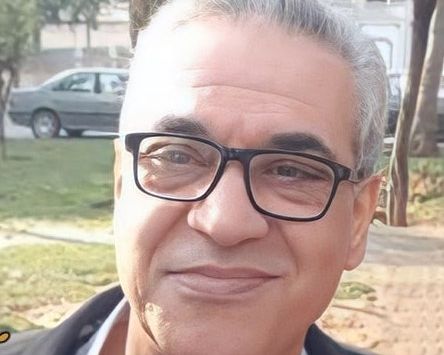
Afif Naimi, one of the former leaders of Iran's persecuted Baha'i community, was arrested by security forces on Saturday.

Afif Naimi, one of the former leaders of Iran's persecuted Baha'i community, was arrested by security forces on Saturday.
Baha'i activists say Naimi was spending a holiday with his family and relatives in a resort in Karaj in the outskirts of Tehran, when more than ten security agents entered and arrested him.
The arrest of the Baha'i citizen comes less than four months after his release on bail.
He suffers from heart disease and passed out many times during his previous detention.
This former director of Iran's Baha'i community known as "Yaran" was sentenced to seven years in prison and a fine of fifty billion rials (100,000 USD) by the Karaj Revolutionary Court in February last year. His sentence is now being appealed.
Two other Bahai community leaders Fariba Kamalabadi, 60, and Mahvash Sabet Shahriari, 70, were handed new 10-year sentences in December after having served 10 years previously on charges of threatening national security.
The 1979 constitution of the Islamic Republic recognizes only Islam, Christianity, Judaism and Zoroastrianism. Supreme Leader Ali Khamenei has on several occasions called the Baha'i faith a cult and in a religious fatwa in 2018 forbade contact, including business dealings, with followers of the faith.
Baha'is, who number around 300,000 in Iran, say their rights are systematically violated and they are often harassed, forced to leave their homes and businesses, and are deprived of government jobs and university education.

Iran said Sunday that the first shipment of Chinese cars is about to hit the market while the minister responsible for the country's car industry was impeached over his lackadaisical performance.
According to reports, the shipment was unloaded at Aprin dry port -- an inland intermodal terminal near Tehran directly connected by road or rail to a seaport. This shipment includes 1,108 Changan CS35s and 125 Changan CS55s imported by Iranian automaker Saipa.
Mehdi Zeighami, the director of the car import plan at the Ministry of Industry, Mine and Trade, said on Sunday that the import was finally carried out “after a five-year hiatus.” He did not say if this is anyhow related to the impeachment of Industry Minister Reza Fatemi-Amin, who appeared at the parliament on the same day to defend his ministry’s performance about the car industry. Even if it was a publicity stunt by the ministry, it did not prove to be effective as Fatemi-Amin could not convince the lawmakers and was sacked anyway.

There are a couple of noteworthy points about the plan to import the cars from the Chinese company. The government plans to import about 100,000 cars from one single Chinese state-owned company, Changan Automobile, by the end of the current Iranian year – March 20, 2024. And the entire project will be done by Saipa, one of the Iranian state-owned companies with a monopoly in manufacturing automobiles. The fact that there is no competition in the import project as no businesses can take part in it makes the whole affair more prone to corruption.

For years critics and politicians have criticized the government-controlled auto industry and have referred to a “mafia” running the money-losing and inefficient sector. In 2019, it was revealed that these carmakers owed $9 billion, a considerable sum in Iran, due to corruption and mismanagement. "Widespread financial corruption has turned automakers in Iran into a powerful Mafia," a lawmaker said at the time.
The carmakers are unable to satisfy domestic demand and they keep raising prices. The government has long restricted car imports, turning the country into a vast parking lot of dilapidated cars.
Changan Automobile is the smallest of the "Big Four" state-owned car manufacturers in China with an annual production capacity of about two million units. It is not clear how the Iranian government came to the conclusion to choose this particular company or if the company would be able to supply the promised 100,000 cars in addition to its other supply commitments.
Another crucial question is how Iran is planning to pay for 100,000 cars when it is under US banking sanctions. The answer can be simple: Use oil import money China owes in a cars for fuel barter deal.
First, making people so eager to get one of the long-sought-after imported cars that they sign up for the plan and pay in advance for a nebulous purchase; second, a murky contract between two state-owned companies from Iran and China without providing any details about the total amount of transactions and number of cars; third, cashing on people’s money as the price of cars can be updated and increased with every shipment of cars. The whole affair can easily be a method by the regime, which faces difficulties to access its oil revenues, to barter oil for cars with China and get the money from the nation.

According to Zeighami, the final price of the imported cars will be announced in the coming weeks. The Central Bank of Iran has blocked at least 96 trillion rials ($2 billion) of prospective customer's money in the cars pre-sales scheme without determining the models of the cars, availability, or the final price since early March. Prospective buyers had to deposit at least five billion rials ($10,000) to book the purchase of an imported car and over 120,000 people signed up for the plan.
Now it is apparent that most of the cars will be Changans, although Zeighami claims that 1,500 other cars will also be imported,which will be from other carmakers such as Fiat, Hyundai, Kia and Mitsubishi.
A lawmaker representing Tehran, Somayeh Rafiei, said in a TV show last week that the axed industry minister told her that the total demand for cars in the country is about two million units.
Iran’s two main carmakers – Saipa and Iran Khodro – can only produce 1,400,000 units of light and heavy vehicles, mostly sub-standard older foreign models.
The chairman of the Association of Car Scrapping Centers said last week that currently 14 to 15 million junk vehicles are on the roads, consuming at least 33 million liters of gasoline (8.7 million gallons) a day.
All things considered, the entire car import scheme and the impeachment of the minister seems like a cunning plot by the government.

Iran’s parliament impeached industry minister Reza Fatemi-Amin Sunday for the current economic crisis, despite a direct intervention by President Ebrahim Raisi.
The session lasting more than six hours was marked by attacks from his opponents, Raisi’s speech and Fatemi-Amin’s own defense of his performance.
Statements by lawmakers as well as Raisi and his minister was a classic show that revealed some of the regime’s behavior in attributing serious issues to the shortcomings of individual officials rather than systemic problems in Iran’s governance.
The most remarkable revelation was not what critics said, but what Raisi and Fatemi-Amin admitted to be the existence of a “car mafia” in the country that dictates policy and prevents imports of decent passenger vehicles at normal prices, producing sub-standard and expensive local vehicles.
For years critics and politicians have criticized the government-controlled auto industry and have referred to a “mafia” running the money-losing and inefficient sector, largely owned by the government.
In 2019, it was revealed that carmakers owed $9 billion, a considerable sum in Iran, due to corruption and mismanagement.
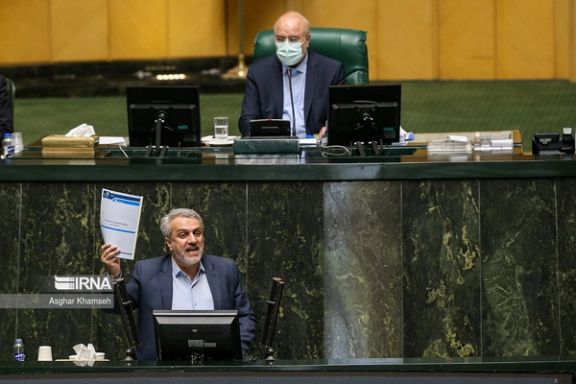
However, lawmakers held Fatemi-Amin responsible for rising car prices, instead of criticizing lack of competition, the centrally-run economy that leads to political interference and the falling Iranian currency, which has led to a higher than 50-percent annual inflation rate.
To be certain, Fatemi-Amin is just an average Islamic Republic official, who would not be capable of improving the fundamentals of the country’s mismanaged economy, even if he were a business and economic genius.
But at the dangerous juncture of a deepening economic crisis and approaching parliamentary elections in ten months, it seems that someone had to be held responsible, even by a parliament stacked with hardliners who initially supported Raisi’s government.
The Iranian rial has again began to fall against the US dollar and other major currencies, dropping to near 550,000 to the dollar on Sunday. This can only mean more inflation, while tens of millions of people have already become impoverished since 2018 when the United States imposed economic sanctions to force Iran to make concessions in its nuclear and military programs.
Recent allegations that Fatemi-Amin gave out 70 SUV vehicles to lawmakers to prevent their first attempt at collecting sufficient signatures for his impeachment, was the last blow that sealed his fate.
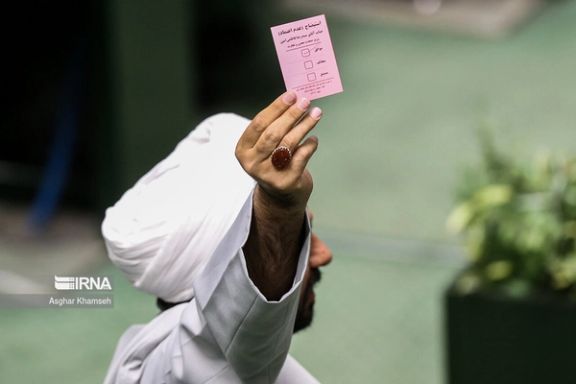
In his speech, the minister claimed that the “car mafia” spent money to discredit him, and even unknown assailants attacked and beat up his deputy, without the judiciary seriously following up on the incident.
He claimed that the “car mafia” had ways to prevent him from lowering vehicle prices. However, one lawmaker responded that if the minister is the people’s representative, why the “car mafia” has gone to great lengths recently to pressure members of parliament and prevent his impeachment.
Fatemi-Amin and some of his supporters in parliament also mentioned US sanctions as a an important reason for the disarray in the car industry. Until now, most hardliner lawmakers and their allies in the government had been arguing that sanctions have little impact and the Islamic Republic could stand on its own feet and strengthen the economy.
No regime insiders and few other politicians in Iran dare to speak about the need to reach an agreement with the United States, lift the sanction and alleviate the situation. It seems to be clear to most that the nuclear and diplomatic policies are decided at the higher level of Supreme Leader Ali Khamenei and it is expected from officials to muddle through.
The hard-pressed population can protest, as they have been doing since September, but the regime has no reservation about using deadly force to keep itself in power. Security forces have killed more than 500 civilians in recent months and arrested around 22,000 protesters and dissidents.

With no prospect of controlling Iran’s economic crisis, even high-ranking clerics representing Supreme the Leader have begun speaking out and demanding solutions.
Friday Prayers Imams in some major cities expressed their unhappiness over the government's performance, similar to criticism by many conservatives who backed President Ebrahim Raisi’s election less than two years ago.
Hashem Hosseini Bushehri, the Friday Prayers Imam of Qom, the venue of the country's most important seminary said in his sermon on Friday: "State officials spend most of their time in meetings with unknown results." He suggested that "Decisions made in those meetings should be followed up seriously by executive officials."
Referring to the declining value of Iran’s currency, he said, "The government's monetary policies should not change constantly. Some investors say they cannot count on the government's monetary regulations even for one day as things might change."

Bushehri also echoed Ali Khamenei’s recent remarks criticizing discord among the executive, legislative and judiciary bodies.
Friday Prayer Imams are appointees of the Supreme Leader and often reinforce his messages. Their demand for economic improvement can be seen as a sign that Khamenei’s patience is running out, as high inflation can trigger more protests.
Without mentioning the ongoing strikes and protests in the country's industrial centers, Bushehri called on the government on the occasion of Labor Day to find legal ways to help Iranian workers.
While inflation has topped 50 percent and the rial has halved in value, workers’ monthly salaries hover around $120-150. In the past ten days workers at more than 100 companies and plants went on strike.
Bushehri also called for "a competitive parliamentary election, so that the enemies will not be able to talk sarcastically about low turnout in Iranian elections."
The temporary Friday Prayers Imam of Mashhad, another religious city in Iran, Mohammad Bagher Farzaneh, who was standing in for the firebrand cleric Ahmad Alamolhoda criticized the government for the worsening situation and said: "Economic problems cannot be concealed."
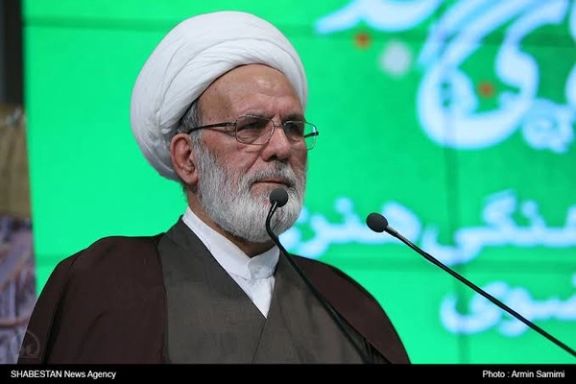
He said more than 51 percent of Iranians in big cities do not own a home and inflation has impoverished ordinary people.
However, also echoing Khamenei he said that the "economic problems can be solved if officials stand united, obey the Supreme Leader and have sympathy for each other." He added that it was a shame that 43 years after the Islamic revolution, the country's leader has to point out discords among the heads of the three powers of the government.
Recently, Ghasem Saedi, a senior lawmaker from Khouzestan Province had said that "The government has ruined the country's economic security," and warned the government that it cannot protect its credibility by chanting meaningless slogans.
In another part of his sermons, Farzaneh said: "Today, no one can claim that the United States does not have any infiltrators in Iran." He said that infiltrators are the main element behind the discord among the country's officials, without saying which high-ranking official in the government is a US infiltrator.
Meanwhile, the Friday Prayer Imam of Tehran, Hassan Aboutorabi-Fard, the only Imam with some executive experience under former President Mahmoud Ahmadinejad, also criticized the government for making economic decisions without thinking about the consequences and without considering the financial resources needed for implementing those decisions.
Aboutorabi-Fard warned the country's "rulers and managers" that their performance will inevitably affect all aspects of people’s life.
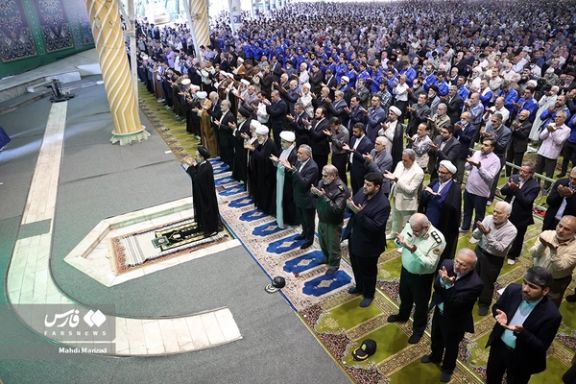
However, it was interesting that he also warned the government that measures to enforce hijab should be taken in a way to boost national unity rather than creating discord among the people and the government.
In recent weeks, as more women have defied the regime’s dress code and appear in public without a veil, hardliners in the government have been pushing for more enforcement measures.
Already, harsh policies against women triggered major nationwide protests leading to more than 500 deaths.

Armed attackers Sunday killed the chief of police Criminal Investigation Department for Saravan County in Iran's Sistan -Baluchistan province.
Nour News, affiliated with the Supreme National Security Council (SNSC), reported that unknown gunmen fired at the car of Major Alireza Shahraki.
The officer's wife was also severely wounded in the attack and taken to hospital in critical condition. Judiciary officials say no one has been detained yet but a manhunt is underway to arrest the perpetrators.
Halvash website that covers Baluchestan events reported that Shahraki used "extremely violent" methods against detainees in the past years.
Earlier in March, two other police officers were gunned down in the restive province with a Sunni-majority population. The attack occurred in a region called Golshan.
Local media identified the two officers as Mohsen Pudinei and Ehsan Shahraki who were shot "while carrying out a security mission regarding Friday prayers".
Last week, tensions built up in Fanuj in the same province after regime forces ran over two motorcycles with their vehicles killing a young man.
The outraged local population took to the streets to protest the actions of the repressive forces in the province. Local media reported that police opened fire at the protesters.
In recent months, pressure on the people in Sistan-Baluchistan has increased, and the situation in various cities has been described as very tense, especially on Fridays, when residents come out to protest against the regime.
The protests began on September 30, 2022, after nationwide unrest broke out following the death of Mahsa Amini.
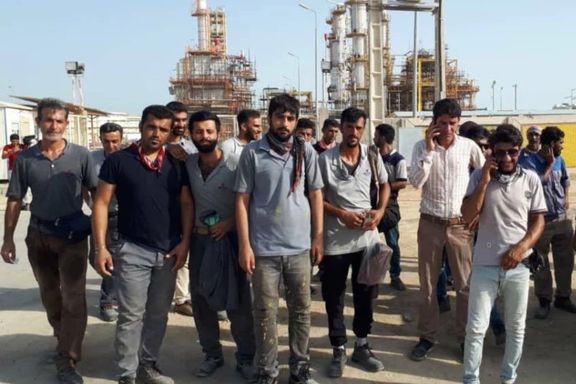
Amid widespread labor protests in Iran, an official says the monthly minimum wage of less than $200 only suffices for "nine days of a family's life".
Hossein Rasouli, an official from the Workers’ House said Saturday that currently, the minimum monthly wage of workers does not even reach eighty million rials (150 USD).
Although the government mandated wage is called the "minimum" wage but that is what most workers receive.
“The wages of the workers have increased by only 27% this year, but this increase is for those workers who are formally employed and does not include a large part of [temporary or contract] workers,” he underlined.
Earlier, the Coordinating Council of Teachers Associations said to prevent further impoverishment of the lower-class wages must be determined in US dollars.
Real incomes in Iran began to lag behind inflation after the establishment of the Islamic Republic in 1979, but salaries were increasing from 2000-2010 when monthly minimum wage hit a high of about $275 in 2010. This coincided with the time when the United Nations Security Council began imposing sanctions to force Tehran to roll back its nuclear program.
A few months into the presidency of Ebrahim Raisi, when inflation was around 40 percent, the High Council of Labor increased the minimum wage by an unprecedented 57 percent in early 2022 after two consecutive years of very high inflation. At the time minimum wage almost equaled $220.
However, the rial lost half of its value in the past 8 months and the minimum wage, without housing allowance, has dropped to around $120 a month.
Rising prices and declining incomes have led to more protests in the previous months with thousands of workers still on strike.